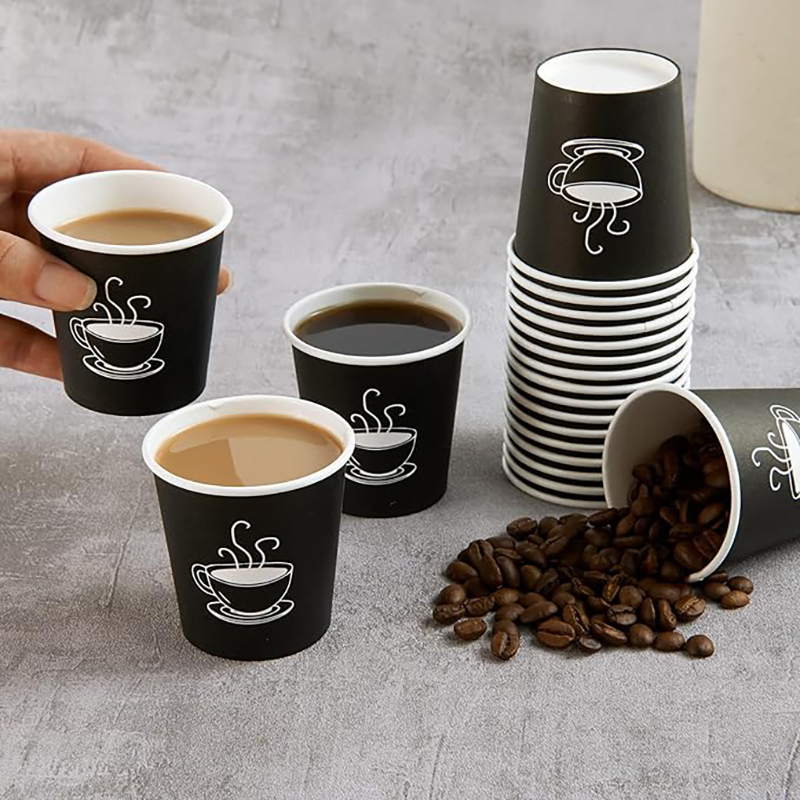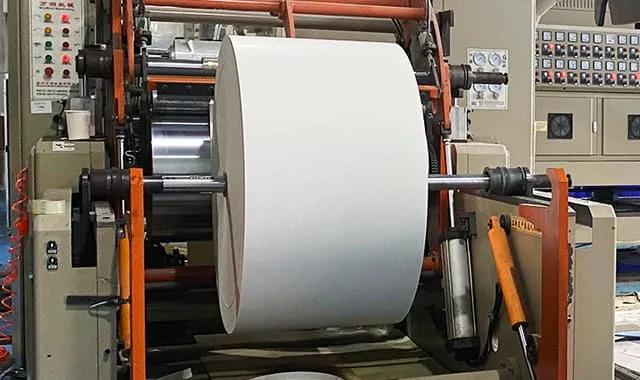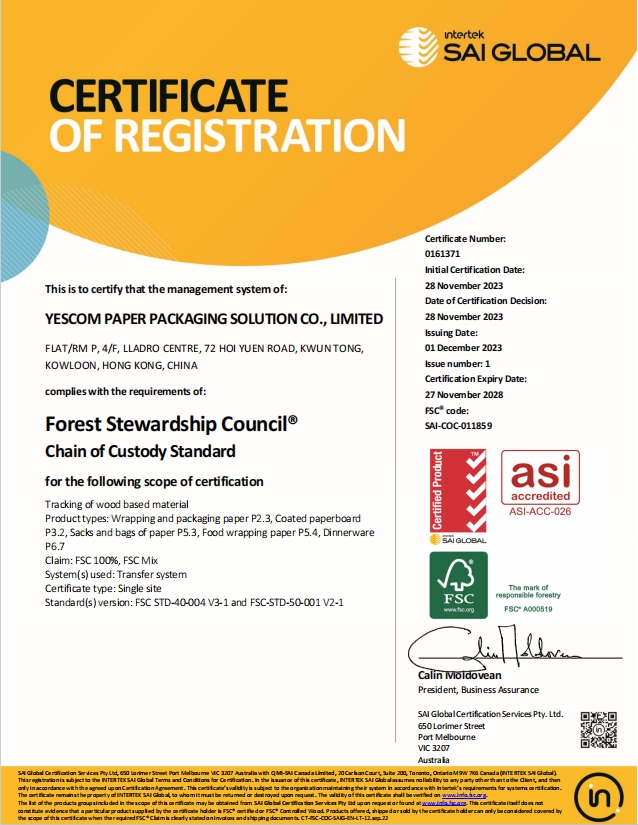cupstock paper manufacturer
Reliable Cupstock Paper Manufacturer
What is cupstock paper? As the premier cupstock paper manufacturer, Yescom Paper specializes in durable, moisture-resistant paperboard for food and beverage packaging, providing an array of customizable, sustainable products.
Products We Offer
- Cupstock Base Paper
- PE Coated Cupstock Paper
- Cup Fans
- Paper Cups & Bowls
We can provide cupstock as raw material and also produce finished paper products

Machines We Have
- Laminating Machine
- Printing Machine
- UV Offset Press
- Die Cutting Machine
All machines are available for producing finished cup products from cupstock base paper.

Forest Stewardship Council
- Credibility
- Assurance
- Sustainability
- Market Access
- Economic Viability
- Social Responsibility
- Environmental Conservation
- Responsible Forest Management
The Certificate of Forest Stewardship Council (FSC) is an important certification that ensures the responsible management of forests. It is a globally recognized certification that guarantees that the forest products, such as timber and paper, come from responsibly managed forests.

Why Choose Us
Competitive Price
Speical offer from the paper manufacturer
Self-Own Factory
We have both pe coating factory and paper cup producing factory.
Proffesional Stuffs
10 more years' experience
As a leading cupstock paper manufacturer, Yescom Paper takes pride in supplying superior paperboard materials tailored for the food and beverage industry.
What is cupstock used for?
Cupstock is a specialized type of paperboard that is specifically designed for the production of cups and other food and beverage packaging. It is made from a combination of raw materials, including wood pulp and various coatings, to create a material that is both durable and resistant to moisture. Cup paper plays a crucial role in the food and beverage industry as it provides a safe and convenient way to package and serve a wide range of products.
The Importance of Cupstock in the Food and Beverage Industry
The use of cup paper for food and beverage packaging offers numerous benefits. Firstly, cup paper provides excellent insulation properties, keeping hot beverages hot and cold beverages cold for longer periods of time. This is particularly important for businesses in the coffee and tea industry, where maintaining the temperature of the beverage is crucial for customer satisfaction.
Additionally, cup paper is highly customizable, allowing businesses to print their logos, branding, and other designs directly onto the cups. This not only enhances brand visibility but also creates a professional and cohesive look for the business. Furthermore, cup paper is lightweight and easy to handle, making it convenient for both businesses and consumers.
Consumer demand for sustainable and eco-friendly packaging has also contributed to the importance of cup paper in the food and beverage industry. With increasing awareness about environmental issues, consumers are actively seeking out products that are packaged in materials that are recyclable or made from sustainable sources. Cupstock manufacturers have responded to this demand by developing eco-friendly options that meet both consumer expectations and regulatory requirements.
Raw Materials Used in Cupstock Manufacturing
Cupstock manufacturing involves the use of several raw materials, including wood pulp, coatings, and additives. Wood pulp is the primary ingredient used in cup paper production, obtained from sustainably managed forests or recycled paper products. The pulp is processed to remove impurities and then mixed with water to create a slurry.
Coatings are applied to the cup paper to enhance its strength, durability, and resistance to moisture. These coatings are typically made from polyethylene, a type of plastic that provides a barrier against liquids. Additives such as fillers and binders may also be included in the cup paper formulation to improve its properties.
Sustainable sourcing of raw materials is a key consideration for cup paper manufacturers. Many companies have implemented responsible sourcing practices, ensuring that the wood pulp used in cup paper production comes from certified sustainable sources. This helps to protect forests and biodiversity while also supporting local communities that depend on forest resources.
Cupstock Manufacturing Process: From Pulp to Finished Product
| Pulp Preparation | Pulp Type | Virgin or Recycled |
| Pulp Consistency | 10-15% | |
| Pulp Bleaching | Chlorine-free | |
| Cup Forming | Cup Size | 8oz, 12oz, 16oz, etc. |
| Cup Wall Thickness | 0.25-0.35mm | |
| Cup Shape | Round or Square | |
| Printing and Cutting | Printing Method | Flexographic or Offset |
| Printing Colors | Up to 6 colors | |
| Cutting Type | Die-cutting or Guillotine | |
| Finishing | Coating | PE or PLA |
| Packaging | Custom or Standard |
The cupstock manufacturing process involves several steps, each crucial in ensuring the quality and performance of the final product. The process begins with the preparation of the wood pulp, which is refined and mixed with water to create a slurry. This slurry is then formed into sheets using a paper machine.
Once the sheets are formed, they undergo a series of treatments to enhance their properties. This includes applying coatings to both sides of the paperboard to provide moisture resistance and improve printability. The coated sheets are then dried and cut into the desired size for cup production.
Quality control measures are implemented throughout the manufacturing process to ensure that the cup paper meets the required standards. This includes testing for strength, moisture resistance, and printability. Any defects or inconsistencies are identified and addressed to maintain product quality.
Types of Cupstock: Single and Double Sided Polyethylene Coated
Cup paper is available in two main types: single-sided polyethylene coated (SSPE) and double-sided polyethylene coated (DSPE). The main difference between these two types lies in the number of sides coated with polyethylene.
SSPE cupstock has one side coated with polyethylene, making it suitable for cold beverage cups or containers that do not require high levels of moisture resistance. DSPE cupstock, on the other hand, has both sides coated with polyethylene, providing superior moisture resistance and making it ideal for hot beverage cups or containers that come into direct contact with liquids.
The choice between SSPE and DSPE cupstock depends on the specific application and requirements of the product. For example, businesses in the fast-food industry may opt for DSPE cupstock to ensure that their hot beverages do not leak or cause the cup to become soggy. Meanwhile, businesses that primarily serve cold beverages may find SSPE cupstock to be a more cost-effective option.
Advantages of Using Cupstock for Food and Beverage Packaging
Cupstock offers several advantages over other packaging materials when it comes to food and beverage packaging. Firstly, cup paper is highly durable and provides excellent insulation properties. This means that it can effectively keep hot beverages hot and cold beverages cold for extended periods of time, ensuring customer satisfaction.
Furthermore, cup paper is highly customizable, allowing businesses to print their logos, branding, and other designs directly onto the cups. This not only enhances brand visibility but also creates a professional and cohesive look for the business. The ability to customize cup paper packaging helps businesses stand out in a competitive market and leaves a lasting impression on consumers.
Cost-effectiveness is another advantage of using cup paper for food and beverage packaging. Cup paper is lightweight, which reduces shipping costs and makes it easier for businesses to handle and store large quantities of cups. Additionally, cup paper is often more affordable compared to other packaging materials such as glass or plastic, making it an attractive option for businesses looking to minimize costs without compromising on quality.
Quality Control Measures in Cupstock Manufacturing
Quality control is a critical aspect of cupstock manufacturing to ensure that the final product meets the required standards. Cupstock manufacturers implement various quality control measures throughout the manufacturing process to identify and address any defects or inconsistencies.
One important aspect of quality control is testing the strength and durability of the cup paper. This involves subjecting the material to various stress tests, such as measuring its resistance to tearing or puncturing. Additionally, cup paper is tested for moisture resistance to ensure that it can effectively withstand contact with liquids without becoming soggy or leaking.
Printability is another key aspect of cup paper quality control. Cupstock manufacturers conduct tests to ensure that the material can be printed on effectively without smudging or fading. This includes testing different printing techniques and inks to determine the best options for achieving high-quality and long-lasting prints.
Future of Cupstock Manufacturing: Trends and Innovations
The future of cup paper manufacturing is shaped by emerging trends and innovations in the food and beverage packaging industry. One key trend is the increasing demand for sustainable packaging solutions. Consumers are becoming more conscious of the environmental impact of their choices and are actively seeking out products that are packaged in materials that are recyclable or made from sustainable sources. Cupstock manufacturers are responding to this demand by developing eco-friendly options that meet both consumer expectations and regulatory requirements.
Another trend is the growing popularity of customization in food and beverage packaging. Businesses are recognizing the importance of branding and creating a unique customer experience. Cupstock manufacturers are investing in advanced printing technologies that allow for high-quality, customizable prints on cups. This includes options for full-color printing, intricate designs, and even personalized cups for special events or promotions.
Innovations in sustainable packaging materials are also shaping the future of cupstock manufacturing. Researchers and manufacturers are exploring alternative raw materials that have a lower environmental impact while still providing the necessary properties for food and beverage packaging. This includes materials derived from agricultural waste, such as bagasse or bamboo, as well as biodegradable or compostable options.
The Role of Cupstock Manufacturers in the Food and Beverage Industry
In conclusion, cup paper plays a vital role in the food and beverage industry by providing a safe, convenient, and sustainable packaging solution. Cupstock manufacturers are continuously working to improve the quality and performance of their products while minimizing their environmental impact. Through responsible sourcing, efficient manufacturing processes, and innovative solutions, cupstock manufacturers are meeting consumer demand for sustainable packaging options and helping businesses create a positive brand image. As the industry continues to evolve, cupstock manufacturers will play a crucial role in shaping the future of food and beverage packaging.
FAQs
What is cupstock?
Cupstock is a type of paperboard that is specifically designed for the production of paper cups and other food packaging products.
What are the benefits of using cupstock paperboard?
Cupstock paperboard is a durable and moisture-resistant material that is ideal for food packaging applications. It is also recyclable and can be made from sustainable materials, making it an environmentally friendly choice.
What types of products can be made from cupstock paperboard?
Cupstock paperboard is primarily used for the production of paper cups, but it can also be used for other food packaging products such as takeout containers, food trays, and snack boxes.
What are some of the key considerations when choosing a cupstock manufacturer?
When choosing a cupstock manufacturer, it is important to consider factors such as the quality of their products, their production capacity, their pricing, and their commitment to sustainability and environmental responsibility. It is also important to choose a manufacturer that can provide reliable and timely delivery of their products.

